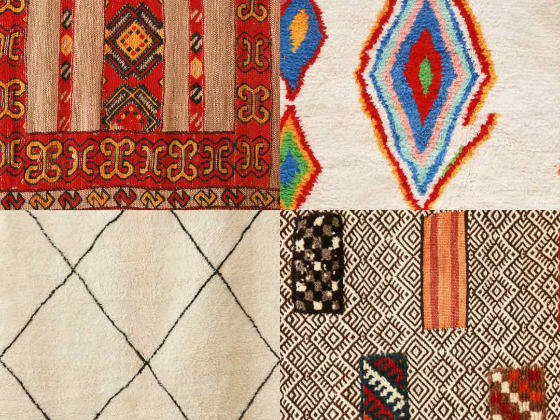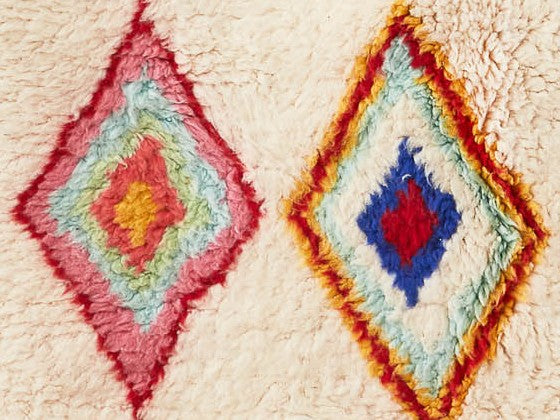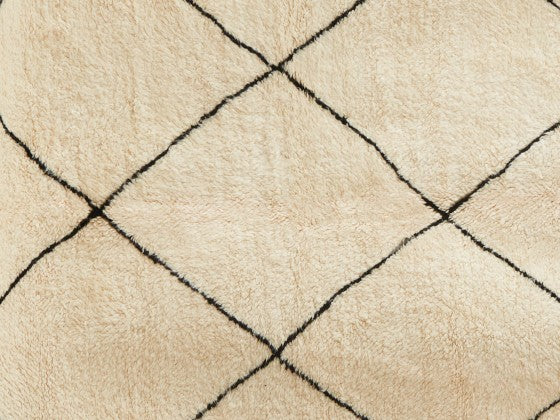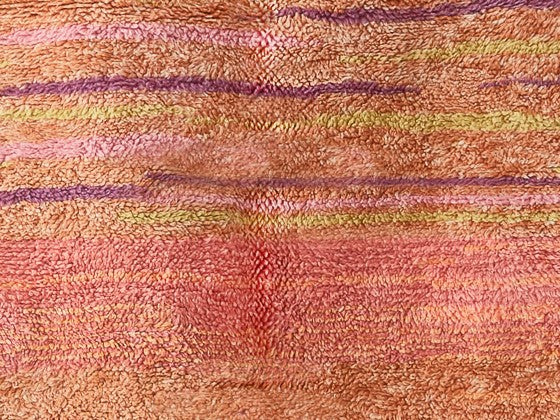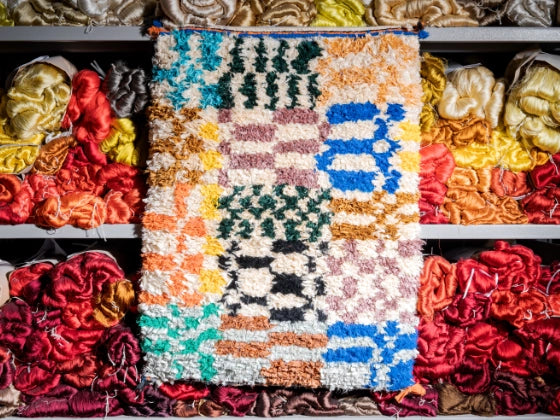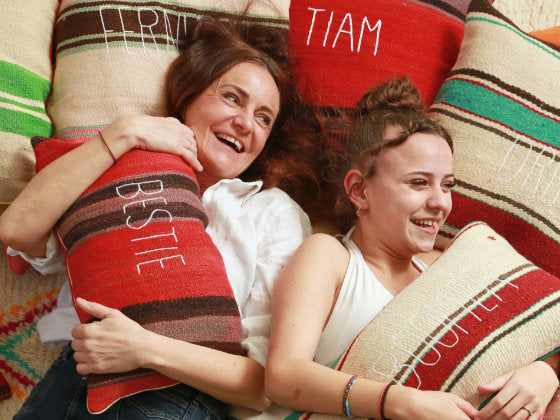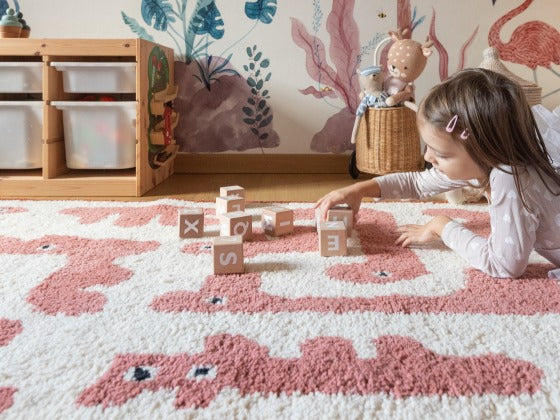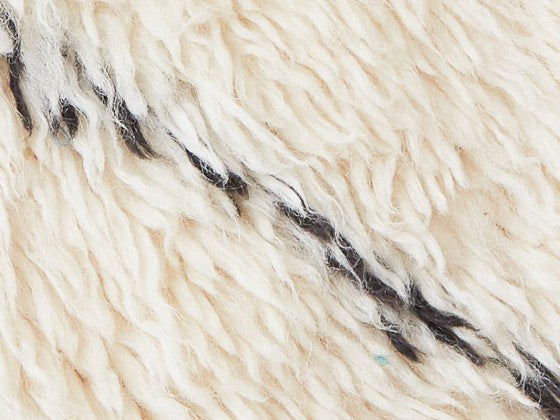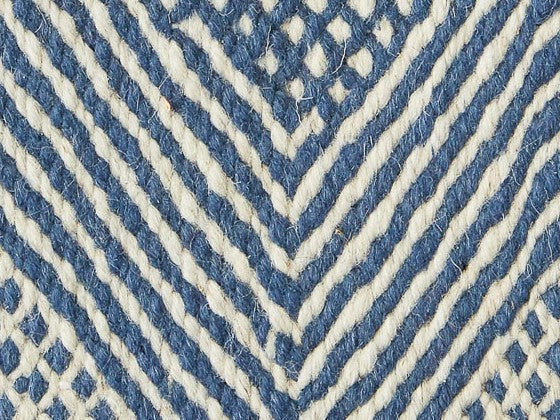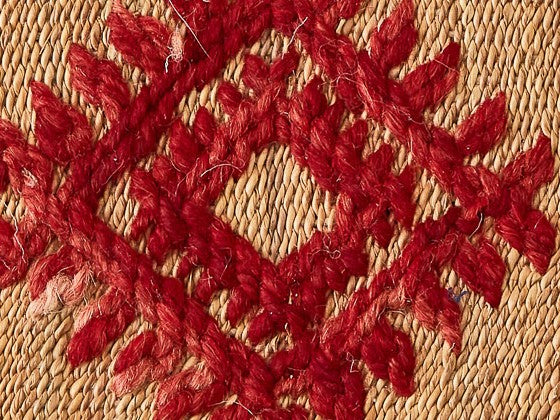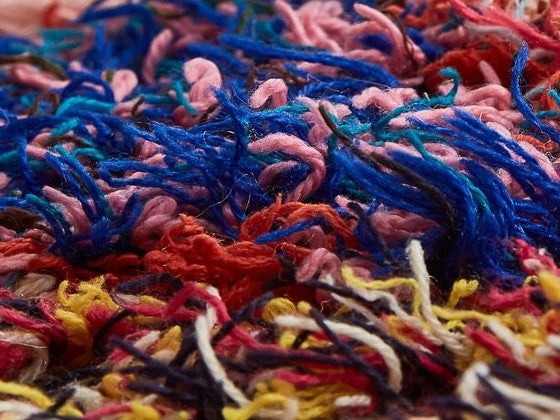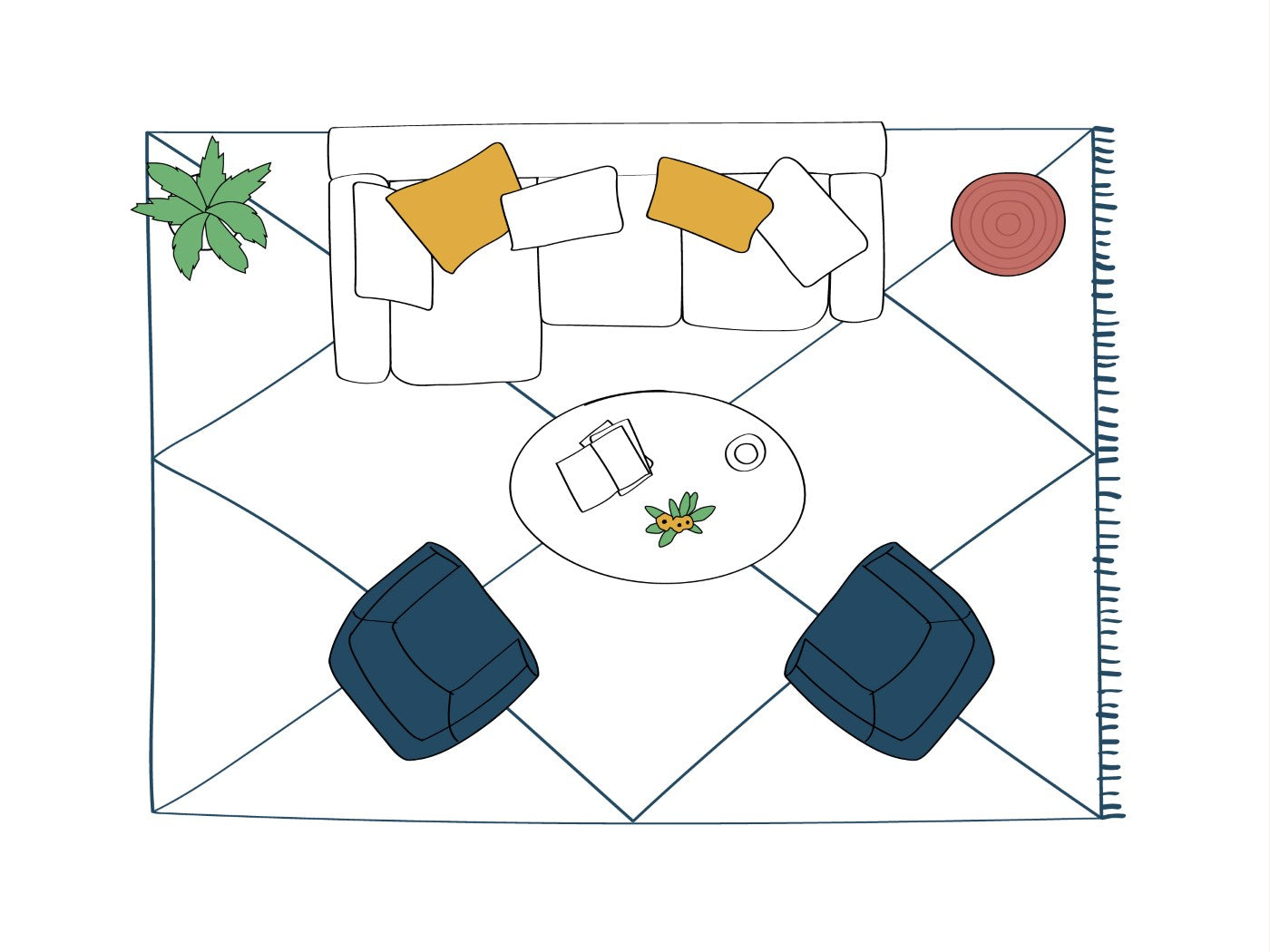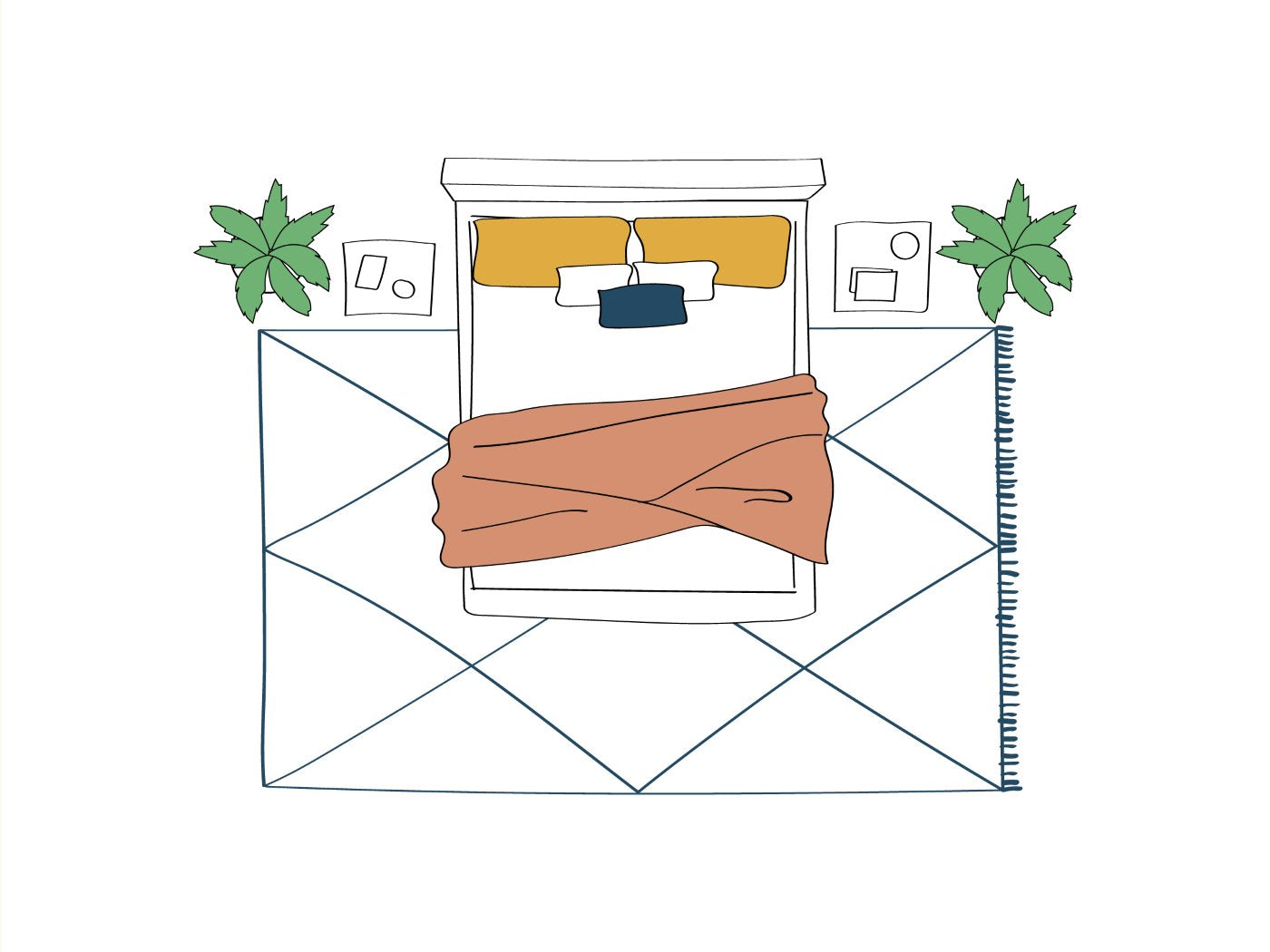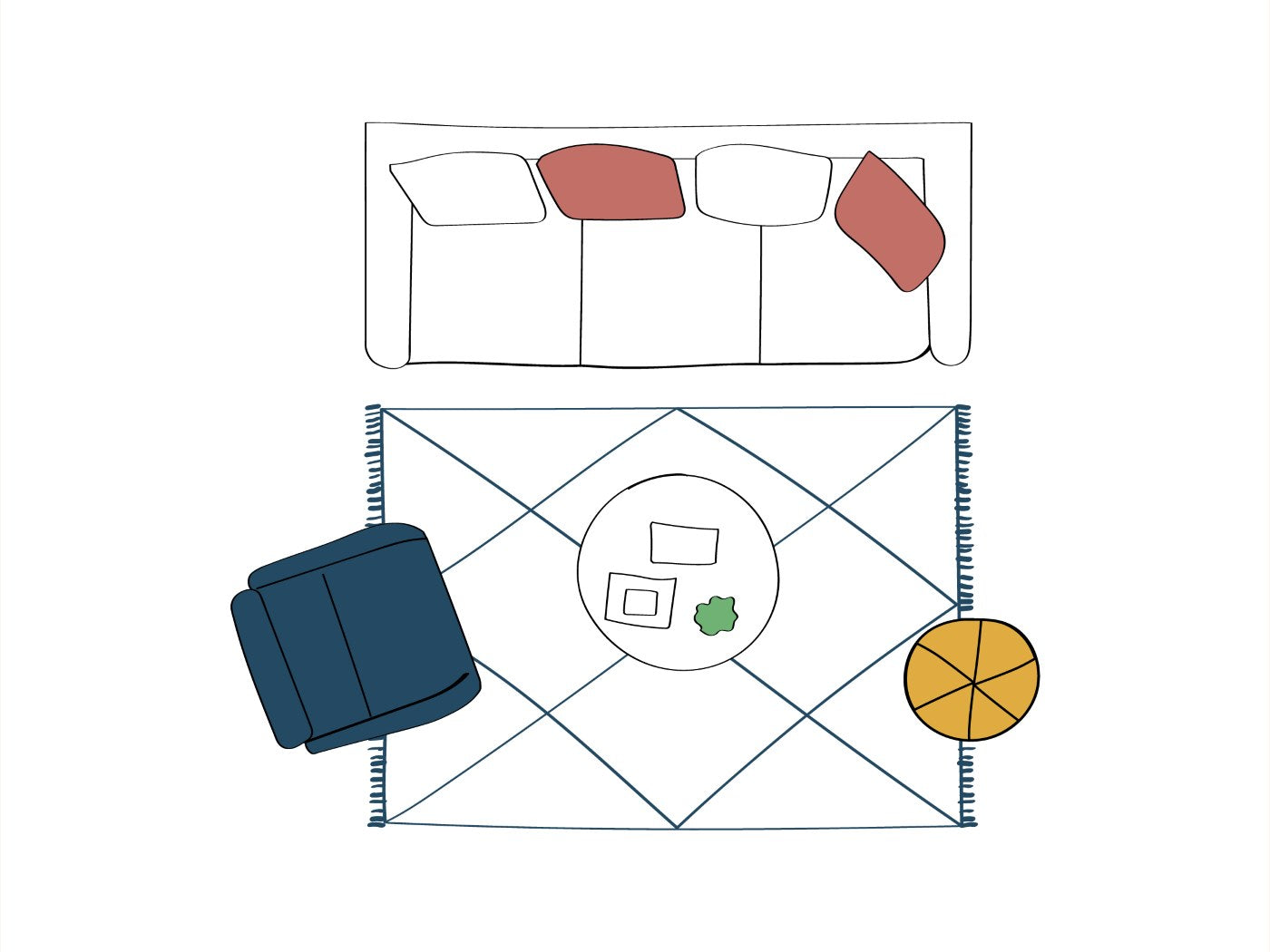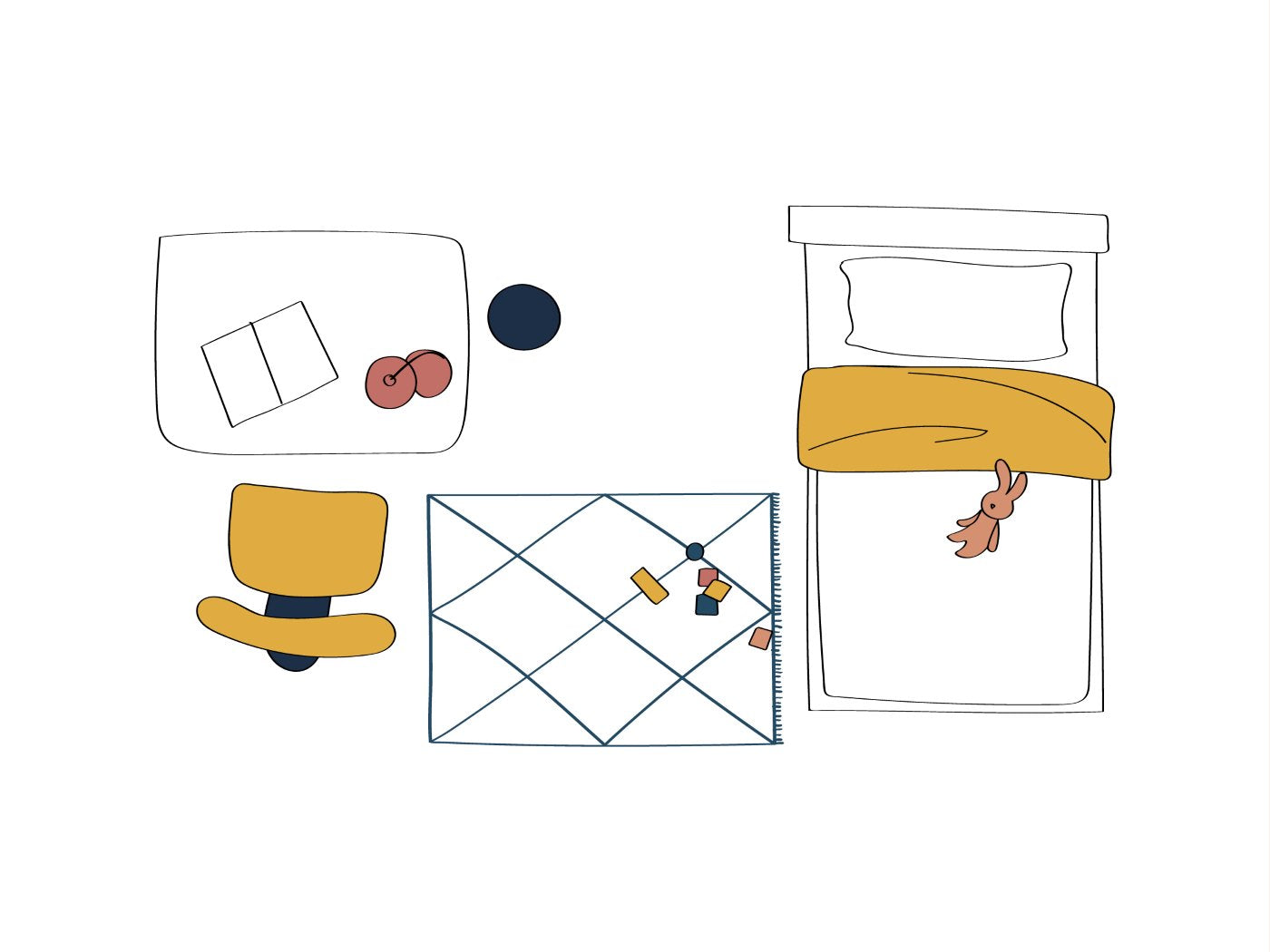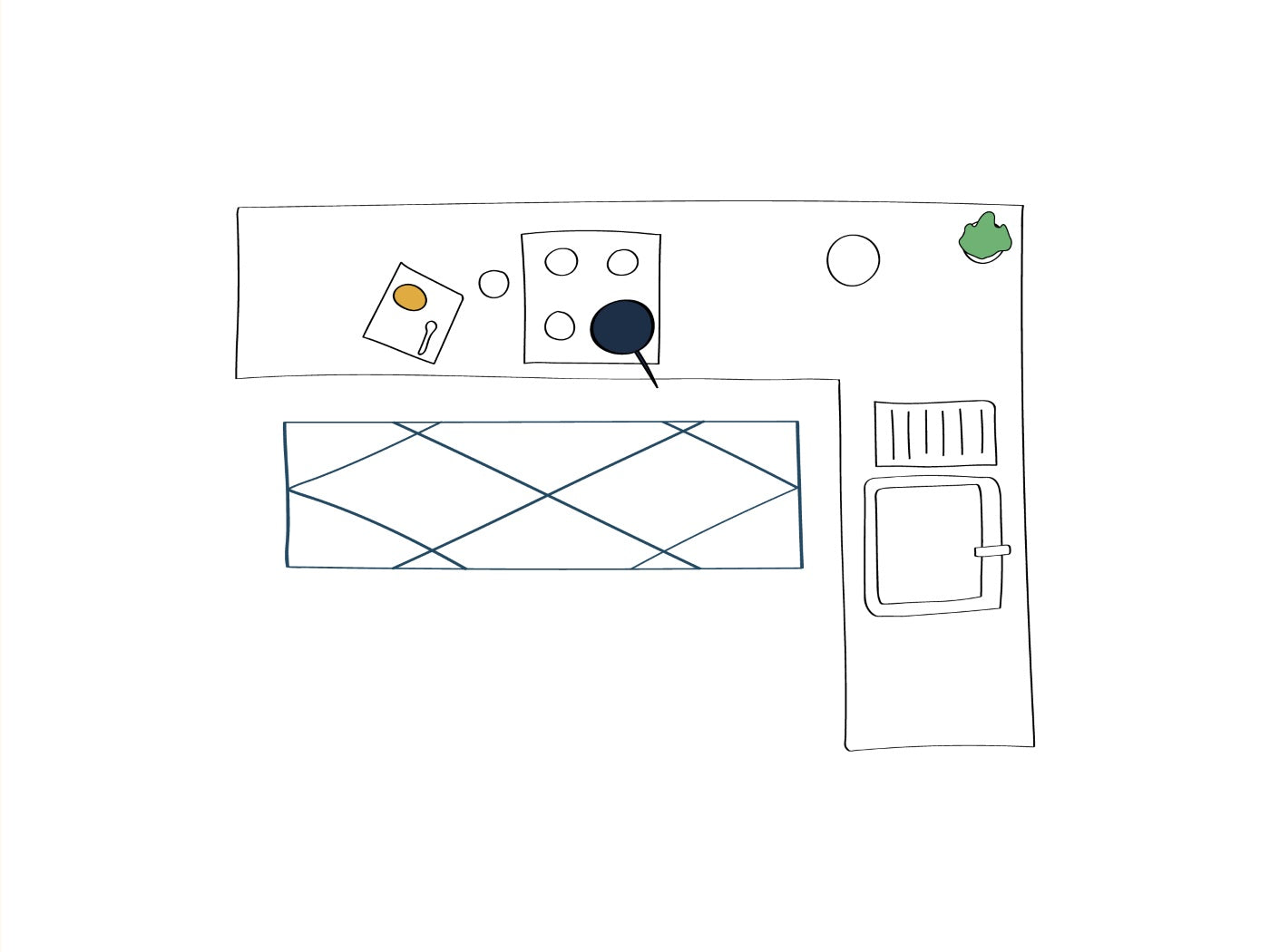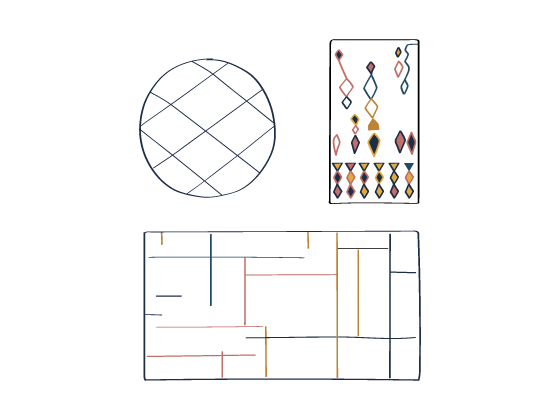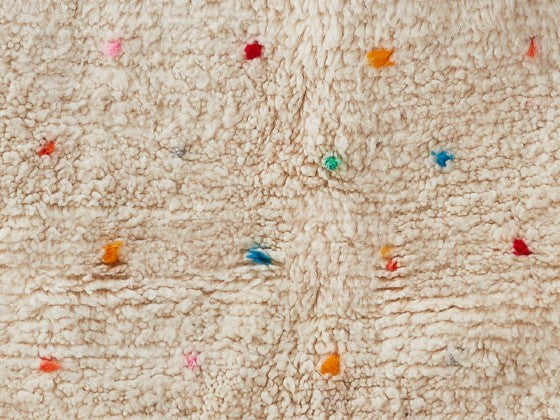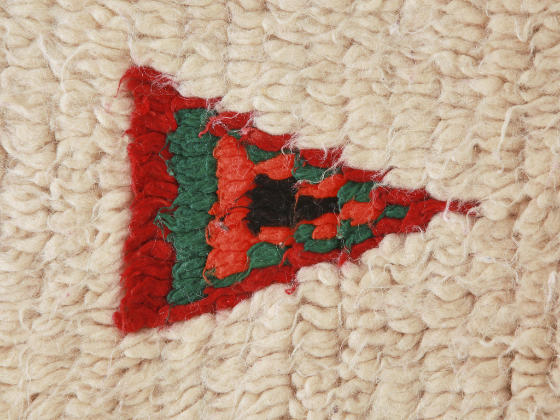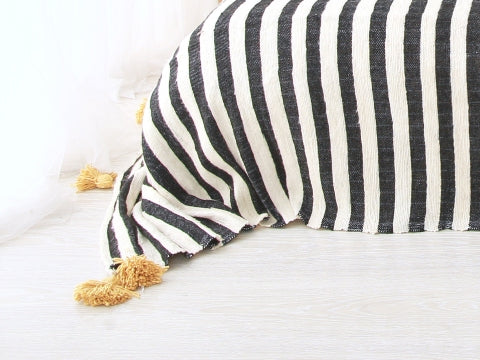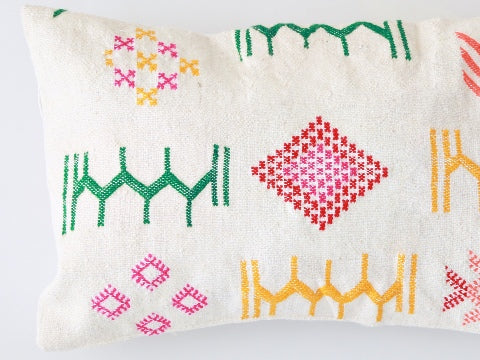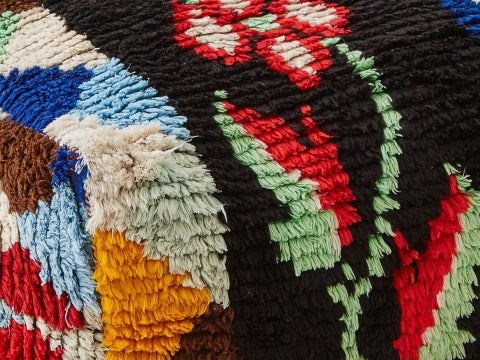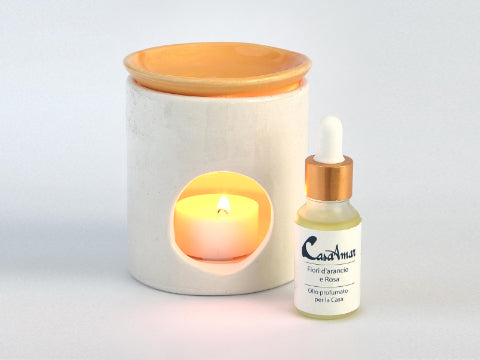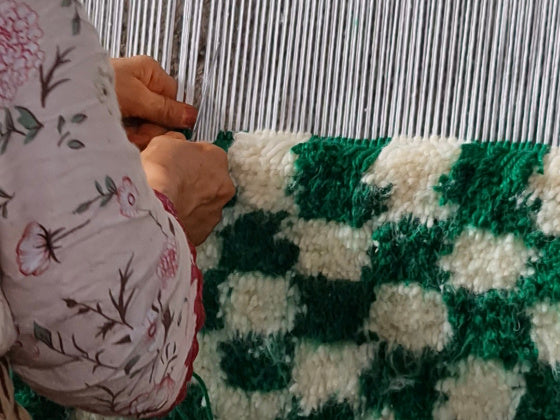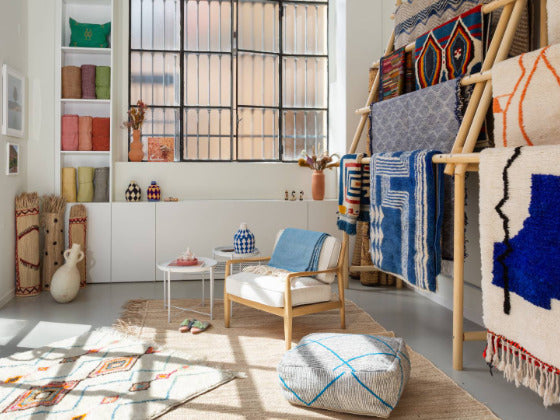Rug care
A practical guide to caring for handmade Moroccan and Amazigh rugs (knotted or woven), whether they are long-pile, short-pile, flat-woven, kilim (hanbel), or made from natural fibers such as Saharan or Tuareg mats ( nattes originating from Mauritania), and Hassira mats from Morocco.
Amazigh rugs, besides being incredibly beautiful, are also durable, easy to clean, and become even more valuable over time. Here, we'll discover how to maintain their durability through cleaning and care, which preserves the beauty of the wool (or other materials they're made of!).
Here you will find real information, no alarmist advice, no unverified remedies . You will finally understand how to wash Moroccan rugs and hand-knotted (or handmade) rugs, avoiding common mistakes and preserving their beauty over time.
Because yes, you can easily clean rugs at home by following our care tips. If you prefer , you can take your Moroccan rugs to a dry cleaner that offers professional cleaning services : it may be worth doing this occasionally, after a few years. In Morocco, rugs are even cleaned at the car wash!
Before tackling the cleaning of Amazigh carpets one by one, we want to reiterate some basic concepts that are very important to us:
- wool is naturally dirt-repellent (those who wear natural fabrics will have already discovered this), therefore it stains rarely and stain removal is simple (because it does not absorb);
- wool rugs (if of adequate size) can easily be washed in the washing machine , using the appropriate washing machine and detergents (formulated for wool, in fact);
- Natural fabrics (including wool) are no more difficult to clean/wash than synthetic ones, on the contrary : the latter get dirty very easily - just think of the fabrics we wear - and absorb stains quickly.
So forget about your worries and clichés, and discover with us how to care for handcrafted Moroccan rugs, depending on the type and stain.
If you have any questions or concerns, we're always here to help!
Cleaning Amazigh carpets is simple, and we believe that taking care of our homes and the objects around us is an integral part of self-care.
Carpet cleaning by type
Each type of Moroccan rug has specific care and maintenance instructions: we will look at them one by one.
If you're not sure what type of rug you bought or can't remember, you can ask us or read our complete guide: What are Moroccan rugs called ?
Cleaning Wool Rugs: 8 General Tips
We'll start with wool rugs, but before we look at the different types, below are some essential tips that apply to all pile types and weaves.
- Shedding : In the first couple of months, knotted rugs may shed excess hair trapped in the wool. This is perfectly normal, as wool is completely natural and the manufacturing process is perfectly artisanal. If you want to speed up this normal shedding process, simply vacuum the rug a little more frequently until all the excess hair has been removed.
This normal loss does not occur in carpets that have already been lived in. - If knots or loose threads appear, they should never be pulled: simply cut them carefully flush with the fleece.
- A crucial note about detergents : wool, like silk, is an animal-based fabric made of proteins. This is why wool detergents must have a neutral or slightly acidic pH (an alkaline pH would destroy the proteins). Therefore, avoid using generic soap, which can felt the wool and damage it*.
- Vacuum cleaner : If you wish to use one, we recommend using the brush attachment usually provided for carpet cleaning, and choosing a low setting. It's recommended to vacuum carefully over the fringes.
- If the carpet gets stained : simply quickly pour in a little cold or warm water, possibly adding a natural soap (such as Marseille soap or a mild detergent). Never use harsh detergents. Then you can dab with a damp cloth and rub gently if necessary.
- Water won't damage your rug, but it's essential to dry it properly, whether with a hair dryer on medium heat or hanging it up to air.
- In general, moisture is not good for wool: therefore, if you need to store your rug in a cellar or any other damp, poorly ventilated place due to a move or renovation, you will need to cover it tightly to protect it from humidity and apply a mothproof product to avoid problems.
- Color test : If in doubt, before washing, you can dab with a white cloth dampened with cold water and a drop of neutral detergent, without rubbing, in an inconspicuous area for 30–60 seconds. If the cloth stains or the color migrates, avoid washing and limit dry cleaning/vacuuming, or take the item to a dry cleaner.
*Source: “The Science of Cleaning” by Dario Bressanini (Gribaudo, 2022)
Shaggy wool rugs

Moroccan long-pile wool rugs, including Beni Ourain, Mrit, and Azilal, appreciate regular care.
Things to remember
- No rotating brushes during vacuuming.
- In case of stains, act immediately by dabbing (do not rub).
- Before extensive washing, do a colorfastness test on an inconspicuous area.
- Dry away from direct sunlight, with good ventilation.
Aspiration (routine)
The first maintenance rule is regular, gentle vacuuming, without rotating brushes. This routine, repeated once or twice a week, is sufficient to remove dust and keep shaggy rugs in good condition without damaging the fibers.
Stains (immediate intervention)
In case of stains, especially on a white wool carpet (where they may be more visible), it is best to act immediately, without rubbing the fabric excessively, but dabbing gently with a clean, absorbent cloth.
To remove stains from a white carpet, all you need is a solution of cold or lukewarm water with a neutral wool detergent or a delicate natural soap (or Marseille soap), applied sparingly and rinsed lightly.
Deodorization (bicarbonate)
A simple and effective remedy for deodorizing and freshening up carpets is baking soda: distributed evenly over the surface and left to act for a few hours, it helps neutralize odors, and can then be vacuumed up completely.
Deep cleaning (dry/wet)
Before any more extensive cleaning, perform a quick colorfastness test on an inconspicuous spot.
A deeper cleaning can be done in several ways. You can opt for the dry method with specific wool powders, vacuumed after a few hours, or a light wet wash, limited to the stained areas. In this case, use a sponge or soft cloth soaked in a small amount of gentle detergent. If the size allows and you need to wash the entire rug, you can even do it in the bathtub, without worrying about getting it wet!
By “light wet wash” we mean a minimal amount of water, a well-wrung cloth, rinsing and quick drying.
Drying
The important thing is to dry the rug thoroughly, laying it flat or hanging it in a ventilated area, away from direct sunlight, until it's completely dry. This prevents the formation of mold or unpleasant odors. Once dry, the long pile can be revived by hand, with a soft comb, or by vacuuming.
Maintenance (rotation and protections)
To maintain its shape and evenly distribute wear, it's good practice to rotate the rug periodically, every three to six months, and protect the areas under furniture with felt pads. This prevents permanent dips and compression of the pile.
Shedding: What it is and how to manage it
When you first start using your rugs at home, they may shed excess pile trapped in the wool. This is perfectly normal, as wool is 100% natural and handcrafted. If you want to speed up this normal shedding process, simply vacuum more frequently until the excess wool is eliminated.
This normal shedding doesn't occur in vintage rugs. It's not a defect but a characteristic of wool, which will fade over time. If knots or loose threads appear, they should never be pulled: simply carefully cut them flush with the pile.
When to call a professional
Finally, if the dirt is particularly stubborn, the rug is very large, or the colors are at risk of fading, it's advisable to contact a professional cleaner specializing in handcrafted rug cleaning. A professional will be able to thoroughly clean the rug while respecting the delicate nature of the wool and the fabric's structure, ensuring a long life for the rug and preserving its original beauty.
Short-pile wool rugs

Short-pile Moroccan wool rugs, such as some traditional Middle Atlas designs, require less maintenance than shag rugs.
Things to remember
- Use the vacuum cleaner with a carpet beater, preferring a moderate speed and avoiding overly aggressive brushes .
- In case of stains , act promptly , dab (do not rub) and use a neutral solution .
- Before treating large areas, perform a colorfastness test on an inconspicuous spot.
- Dry away from direct sunlight in a well-ventilated area.
Aspiration (routine)
The compact structure and thinner pile make it easier to remove dust and dirt, making them easy to vacuum . Unlike long-pile wool rugs, you can use a vacuum cleaner with a carpet beater on standard mode, but if possible, it's best to choose a moderate speed and avoid overly aggressive brushes .
Stains (immediate intervention)
As for stains , here too (and it goes without saying) it's best to intervene promptly . Often, dabbing with a cloth and cleaning with a neutral solution is enough to achieve excellent results. Again, it's best not to rub .
Before treating large surfaces, perform a colorfastness test on an inconspicuous area. After treatment, allow the paint to dry quickly and thoroughly to avoid streaks.
Drying
A handcrafted short-pile rug dries quite quickly when wet, for obvious reasons. Simply lay it flat or hang it in a well-ventilated area, avoiding direct sunlight , which could yellow or fade the wool.
Maintenance (shedding)
Long-term maintenance is also simple here: shedding is much less noticeable in short-pile rugs and they tend to last less .
Recommended use
Handcrafted short-pile wool rugs are often preferred in high traffic areas or in everyday environments because the shorter pile makes them less subject to changes due to foot traffic .
When to contact a laundromat
For large stains, risk of discoloration or doubts about treatment, it is advisable to contact a cleaner specialized in cleaning handmade carpets .
Flat-woven wool kilim rugs (hanbel)

Moroccan kilim rugs are called hanbel , and they differ from long-pile models because they are flat, light, and thin . This structure makes them very practical for daily maintenance .
Things to remember
- Shake in the open air when possible (size permitting) to quickly remove dust and crumbs.
- Suction : regular, following the warp/weft direction to avoid excessive traction.
- Stains : intervene as soon as possible , dab (do not rub), use a neutral solution .
- Color Test : Before washing large areas or the entire carpet, test in an inconspicuous spot.
- Drying : complete, in the shade and in a well-ventilated area.
- For high traffic areas, consider a non-slip underlay (stability + less wear).
Maintenance benefits
One of the advantages of flat Moroccan rugs – when the size allows it – is that they can be easily shaken out in the open air , removing dust and crumbs in a few seconds without having to constantly resort to the vacuum cleaner.
Aspiration (routine)
To clean a kilim/hanbel at home, regular maintenance is sufficient, starting with vacuuming, because the flat weave doesn't trap dust deeply. Whenever possible, follow the warp/weft direction.
Stains (immediate intervention)
The same universal rule applies to stains: act as soon as possible to prevent them from drying and being absorbed too deeply. You can dab the area with cold water and wool detergent .
Hand wash (entire rug or areas)
To wash a kilim/hanbel you can either dab the affected areas or wash the rug completely by wetting it, always leaving the rug to dry thoroughly in a well-ventilated area.
Can you machine wash a kilim rug? When we advise against using the washing machine, we're referring to the fact that we don't know what effect it might have on the color (since they're handmade, we don't know exactly how they were dyed), but it shouldn't be ruled out just because the rugs are made of wool! If the size allows, just follow the usual precautions ( wool/delicate cycle , cold water or max 30°C , low spin , and possibly a bag/protector for the fringes).
Drying
After washing (by hand or in the washing machine), let the rug dry completely in a ventilated and shaded area .
When to contact a professional
If you have any doubts, large stains, or risk of discoloration, contact a specialized laundry.
Recommended use
Another difference compared to long-pile rugs is their ease of maintenance in high-traffic areas : kilim/hanbel rugs can be moved and cleaned more frequently , without the risk of damaging the pile. They are the ideal solution for those who want a durable and practical handcrafted rug.
Boucherouite rugs

Boucherouite rugs are the most creative of the Moroccan tradition: created by reusing scraps of fabric, cotton, wool, and synthetic fibers, they have a colorful patchwork style and cleaning instructions that vary depending on their weaving.
Suction / Shake
If they're small, Boucherouite rugs can be shaken out by hand: it's a very simple solution if you have a garden and can even be done from a window or balcony (respecting condominium rules). You can also shake them in the bathtub or vacuum them , just like all the others! For flat weaves (kilim/hanbel), use low or medium power .
Stains (immediate intervention)
In case of stains , simply wash with cold or lukewarm water and a natural detergent , then rinse with cold water .
Washing machine
You can also wash them in the washing machine on a short hand wash (or delicate) setting , cold and without spinning .
Drying
Just let them air dry .
Ancient Saharan mats

Value and respect
Saharan mats, especially the antique ones, require careful maintenance to preserve their value and ensure their longevity. Although they were designed to withstand the harsh desert conditions, to be rolled, unrolled, and transported, they are still artifacts that must be treated with respect: they are, after all, collector's rugs .
Materials and care
Their handcrafted structure and the organic materials with which they are woven require specific care, both in everyday cleaning and in more extraordinary conservation and restoration interventions.
Daily maintenance
For the daily care of palm wood rugs, simply remove dust with a low-power vacuum cleaner or a soft brush , avoiding accessories with stiff bristles that risk damaging the weave.
Wear and tear
If the mat is walked on regularly, it is useful to rotate it every so often to better distribute the wear.
Light and color
Direct exposure to sunlight for long periods can alter colors, so it is preferable to choose a room in the house where the lighting is more balanced.
Deeper cleaning
You can wipe with a slightly damp cloth , following the direction of the weave , always avoiding excess water , which could damage the fibers or leather. For light stains , you can proceed with hand washing with a natural detergent, as long as you dab gently without rubbing excessively. The important thing is to then remove all traces of soap by rinsing the fibers thoroughly.
Conservation
If the mat needs to be stored for long periods, it is best to roll it up (do not fold it) and wrap it in a breathable cotton sheet , protecting it from excessively humid or hot environments.
Professional restoration
Over time, some areas may weaken or develop small tears . Even leather parts , when they tend to dry out or crack, can be treated with specific natural oils , always sparingly to prevent moisture from penetrating too deeply. In these cases, it's best not to improvise, but to rely on a craftsman experienced in restoring rugs and natural fiber items.
Conservative restoration
For rare, older or valuable carpets , it is advisable to opt for conservative restorations, which respect the original structure without altering their authenticity.
By following these precautions, a Saharan mat retains its charm intact for decades, continuing to convey the beauty and strength of a rare and precious artisan tradition: that of rugs to be preserved forever.
Hassira mats and straw rugs

Daily cleaning
Hassira mats are easy to maintain because they're designed for everyday use. Their natural texture allows for easy removal of dust and dirt: they're easy to clean with a broom or brush . If you want to vacuum, we recommend using the brush attachment typically provided for rugs and choosing a low setting .
Stains and hand washing
To clean a stained straw rug or Hassira mat, you can use a sponge moistened with cold or lukewarm water and soaked in a mild detergent .
Complete wash
You can also wash it completely: at home (if you have a garden or a pool too), at the laundromat ... or even at the car wash like we do in Morocco!
Outdoor use
Thanks to their resistance , Hassira rugs could be used as outdoor rugs, but since humidity and rain can compromise the durability of the natural fibre, we suggest using them only in covered and protected outdoor areas .
Zindekh Tapestries

Since they are made from mixed yarns, we recommend hand washing Zindekh rugs/tapestries or taking them to a dry cleaner .
Otherwise, they're very easy to clean: you can vacuum them or shake them outside to remove dust. And for stains or surface dirt, all you need is water and detergent for effective, hassle-free cleaning. If used as paintings or tapestries, simply dust them regularly.
Anyone who buys a handcrafted Moroccan rug knows they are bringing home a piece of history, art, a valuable artifact that—though durable—requires a minimum amount of attention and small but constant care.
This page is intended to answer the most frequently asked questions, but if you have any specific questions or concerns, please feel free to contact us.
FAQ | Mistakes to avoid, homemade and natural cleaning methods, stains and remedies
Wool rugs
You can vacuum regularly on low or moderate power. It is recommended to carefully vacuum the fringes.
During the first few weeks, knotted rugs may lose the excess hair trapped in the wool: this is completely normal, because the wool is perfectly natural and the manufacturing process is perfectly artisanal. If you want to speed up this normal shedding process, just vacuum a little more frequently until the rug has lost all the excess.
However, this normal loss does not occur in carpets that have already been worn.
If the ruggets stained, just quickly pour in a little cold or lukewarm water, possibly with the addition of a natural soap (such as Marseille soap or a delicate detergent). Never use aggressive detergents. Then you can dab with a damp cloth and if necessary, rub gently.
Water does not damage the carpet: however, it is essential to dry it correctly, either with a hairdryer with medium-hot air or by hanging it in such a way as to allow it to air.
In general, humidity is not good for wool. Therefore, if for reasons of moving or work you need to store the rug in a cellar or any humid and unventilated place, it will be necessary to cover it in an airtight way protecting it from humidity.
Boucherouite rugs
f they are small, Boucherouite rugs can also be pushed out with just your hands: it is a very simple solution if you have a garden and it can also be done from a window or a small balcony (in compliance with condominium rules). You can even bang him in the bathtub!
If the Boucherouite rugs are flat-woven (kilim/hanbel), you can safely use the vacuum cleaner, choosing low or medium power. You can also wash them in the washing machine with a short hand wash mode, cold and without spinning. Just let them air dry.
If the Boucherouite instead has "a hair" (regardless of the material), it is not recommended to use the vacuum cleaner unless you do it rarely, with very low power and ideally with the brush usually supplied as an accessory for cleaning carpets. In case of stains, simply wash with cold or lukewarm water and a natural soap, then rinse with cold water.
Oltre ai metodi citati qui potete lavare un tappeto marocchino anche con una macchina pulisci tappeti. Siamo sinceri: noi non abbiamo esperienza diretta perché non abbiamo mai avuto necessità di utilizzare una lavatappeti ma abbiamo conferma da diversi clienti che si trovano bene e la usano abitualmente.
Questi dispositivi combinano funzioni diverse: alcune sono pensate per lavorare a secco, utilizzando polveri assorbenti da aspirare con delicatezza; altre sono vere e proprie lavatappeti a vapore o ad acqua con detergenti, capaci di sciogliere lo sporco più ostinato. Esistono anche modelli compatti, le cosiddette lavatappeti portatili, utili per tappeti di piccole dimensioni o per intervenire su singole macchie. L’importante è - come specificato anche per il lavaggio a mano - utilizzare detergenti specifici per la lana.
Tra i marchi più affidabili per l’uso domestico su tessuti come la lana spiccano Bissell, Kärcher, Hoover e Vorwerk (Folletto), che offrono macchine specifiche per la pulizia profonda di tappeti senza compromettere le fibre. Altre soluzioni, come i modelli a vapore di Polti o i sistemi multifunzione di Dyson, possono essere utili per la manutenzione ordinaria, ma è sempre bene usare programmi delicati e detergenti neutri. Rivolgetevi comunque ai produttori per capire se la macchina lavatappeti è adatta al vostro tappeto perché queste sono informazioni generiche.
Quando si parla di rimedi della nonna per pulire tappeti, serve distinguere tra soluzioni davvero utili e “leggende” che rischiano di danneggiare le fibre. Ecco qualche linea guida utile se volete fare una pulizia tappeti senza aspirapolvere o senza prodotti aggressivi:
SÌ ✨
- Bicarbonato: ottimo per assorbire umidità e cattivi odori, da lasciare agire a secco e poi rimuovere con una spazzola.
- Terra di Sommières: eccellente per macchie grasse o aloni su tappeti in lana, alternativa naturale ai prodotti chimici.
- Spazzolatura delicata: con una spazzola morbida in setole naturali per rinfrescare il vello senza rischiare danni.
NO 🚫
- Aceto: spesso citato nei rimedi casalinghi, ma rischia di scolorire i tappeti in lana e di irrigidire le fibre.
- Schiuma da barba: un classico “trucco da forum”, ma gli additivi possono macchiare o incollare il pelo. Meglio evitarla.
- Esposizione prolungata al sole: può alterare i colori e indebolire la lana, quindi sì a un po’ d’aria fresca, no a giornate intere sotto il sole diretto.
In sintesi, alcuni metodi naturali funzionano davvero, altri vanno considerati solo come miti da sfatare. In linea generale possono essere utilizzati prodotti leggermente acidi ma mai quelli alcalini, che rovinano invece la lana.
Hassira mats
They are easily cleaned with a broom or brush. If you need to clean a specific stain, you can use a sponge moistened with cold or lukewarm water and soaked in a delicate detergent.
If you wish to use a vacuum cleaner, we recommend using the brush usually supplied as an accessory to clean carpets and choosing a low power.

